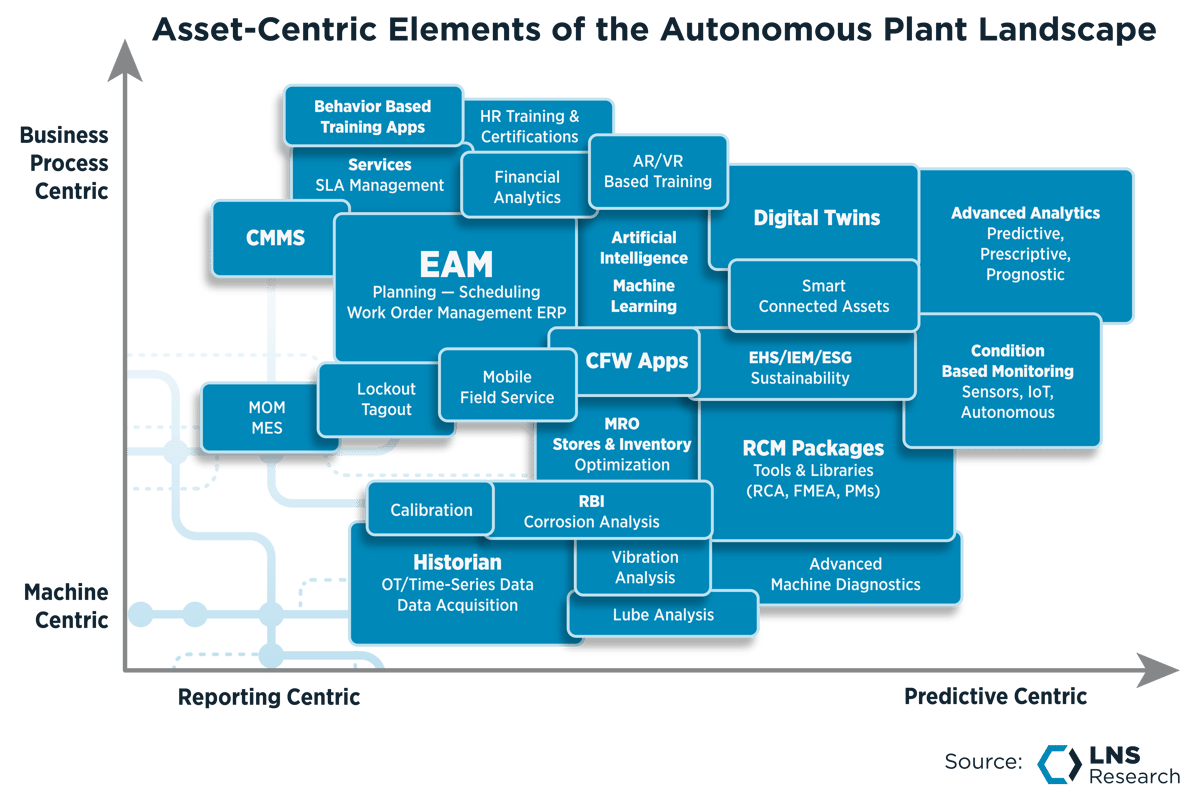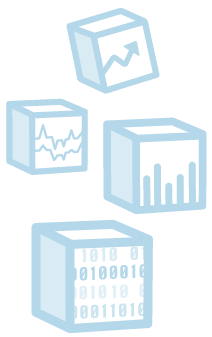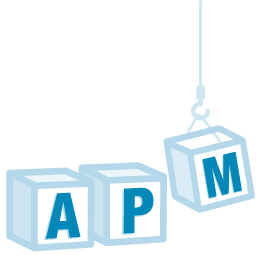Bentley Systems and its AssetWise Suite of APM Applications
LNS Research explores individual Asset Performance Management (APM) vendors from the new APM Solutions Selection Guide.
Asset Performance Management (APM) emerged in the early 2000s to deliver three core business outcomes for asset-intensive companies: reduce maintenance costs, improve production availability, and increase asset reliability. APM was, is, and will always anchor on understanding risk, cost, and performance. There are a number of important connected objectives/outcomes, such as reduced downtime and improved safety, but these essential pillars of the APM vision remain at the core of what solutions providers in the APM space are developing software to deliver today.
The LNS Research definition and inclusion criteria for our APM research rests on the system-of-systems foundation where connectivity and interoperability between technologies, software-driven methodologies, and systems ensure a successful APM program.
A modern, digital APM solution brings together a set of these capabilities to provide the following outcomes:
A holistic understanding of risk
A predictive early warning of asset failure
An understanding of the consequence of failure
Generated insights (strategies) to mitigate asset failure
Seamless data portability into and through APM
In Figure 1 below, we lay out the Asset-Centric Elements of the Autonomous Plant Landscape. Asset Performance Management (APM) software brings together many of these capabilities to deliver a comprehensive solution. The model illustrates the ranges from Reporting Centric to Predictive Centric (X-Axis) and Machine Centric to Business Process Centric (Y-Axis).
 Figure 1
Figure 1The ecosystem ranges from basic maintenance functions and point solutions to very advanced Causal AI and multivariate scenario analysis. These advanced AI-powered APM software systems enable the simultaneous examination of multiple variables to understand how they interact and influence each other to provide a more comprehensive and accurate assessment of risk and overall asset performance and then deliver prescriptive and prognostic strategies for improvement.
For nearly 20 years, APM software has been delivering greater asset/plant reliability and lower maintenance costs. In our 2023 LNS Research State of IX Tech survey of 321 manufacturing leaders, we found that 70% of IX Leaders had implemented APM software enterprise-wide. However, that number drops to only 55% when the data is cut for "all participants." Obviously, this varies by industry, with much higher enterprise-wide implementation in the Oil & Gas and Chemical verticals and lower within Consumer Packaged Goods or Life Sciences.
When asked about APM adoption and enterprise deployment, these numbers reflect the challenges owner/operators cite. The list is long, but the most common challenges include:
Integration and data flow: Where siloed data from disparate systems and point solutions is trapped and hampers the ability to generate comprehensive insights into asset performance, compromises risk calculations, and limits optimization opportunities.
Scalability: Where a "best of breed" approach to solution selection over the years, combined with the lack of an agreed enterprise reference architecture, limits the ability to deploy new technologies uniformly across all plants in the enterprise.
User Adoption: As the experienced maintenance, reliability, and asset management workforce retire, companies are struggling to attract, hire, train, and retain these skilled positions, which are needed to ensure successful implementation, user adoption, and scale.
Figure 2 below is the LNS Research view of a comprehensive Asset Performance Management (APM) software solution. Elements identified in our model include "Core" APM functionality and "Supporting/Emerging" capabilities that provide a critical input or function to a connected system. For example, APM does not replace an Environmental, Health, and Safety (EHS) system, but when APM identifies an asset failure where the loss of containment of a hazardous material is a possible outcome, it triggers safety procedures in the EHS system.
%20Software.png?width=1200&height=771&name=Asset%20Performance%20Management%20(APM)%20Software.png) Figure 2
Figure 2The Methodologies & Asset Strategies domain contains the primary approaches used to achieve the APM business objectives of developing a holistic understanding of risk, enabling a predictive early warning of asset failure, with an understanding of the consequence of failure, and ultimately results in generating insights (asset strategies) to mitigate asset failure.
APM Core Capabilities. Will be evaluated in the 2024 APM SSM:
Preventative Maintenance (PM) is a proactive maintenance strategy that involves regularly scheduled tasks and inspections to maintain the health and functionality of equipment or assets. The goal is to prevent unexpected equipment failures and extend asset lifespan. A successful PM program addresses potential issues before they become critical, minimizing downtime and reducing repair costs.
Reliability Centered Maintenance (RCM) is a methodology for systematically optimizing maintenance programs for physical assets. Its goal is to achieve the desired asset reliability and serviceability level at the lowest achievable cost. The primary components are FMEA, Risk Assessment, and Strategy Development to determine the most effective and cost-efficient maintenance tasks for each failure mode based on criticality and cost considerations.
Condition-based Maintenance (CbM) is a proactive methodology that focuses on monitoring the actual condition of assets to determine when maintenance is needed. Unlike traditional preventative maintenance schedules based on time or usage, CbM relies on real-time data and analysis to optimize maintenance timing and resources.
Predictive Maintenance (PdM), better described as predictive analytics for maintenance, is a data-driven approach to maintenance that leverages advanced analytics and, in some systems, utilizes Artificial Intelligence (AI) principles of Machine Learning (ML) to predict when equipment is likely to fail.
Root Cause Analysis (RCA) is a systematic approach to identifying the underlying cause of asset failure. It goes beyond simply addressing the symptoms to discover the root source of the issue so that asset strategies and/or maintenance procedures can be updated, preventing the failure from recurring.
Supporting/Emerging Capabilities:
(Generally, RBI is only used in Refining and Chemical Process Industries)
Risk-Based Inspection (RBI) is a systematic approach to prioritizing and managing inspection plans for equipment and assets based on their associated risks. RBI quantifies the likelihood and consequences of failure (PoF and CoF) for each piece of equipment, allowing for efficient resource allocation and targeted inspection activities. RBI supports API 580 and API 581 recommended practices.
Asset Investment Planning (AIP) is a component of APM facilitating the strategic process of allocating capital to maximize the return on investment (ROI) from a manufacturing/plant asset base. In simpler terms, it helps you decide when and where to invest in your assets to keep them performing optimally and achieve your long-term operational goals.
The model's Advanced Analytics & Visualization domain contains the enabling technology for diagnostic, predictive, prescriptive, and prognostic analytics. The introduction of Artificial Intelligence (AI), specifically the Machine Learning (ML) discipline of AI, has brought significant capabilities to the APM landscape - anomaly detection being the most common use case. Digital Transformation initiatives have accelerated the use of IoT "smart" sensor devices to enable broader real-time CbM. Digital Twin use cases include analyzing the impact of different maintenance actions in the virtual environment to minimize risks and optimize real-world implementation.
APM Core Capabilities. Will be evaluated in the 2024 APM SSM:
 AI/ML/Anomaly Detection: Machine Learning algorithms analyze process data from Historians and real-time data such as vibration and temperature from sensors, trained to look for patterns and deviations from normal operations, identifying anomalies that might indicate potential failures as a part of PdM.
AI/ML/Anomaly Detection: Machine Learning algorithms analyze process data from Historians and real-time data such as vibration and temperature from sensors, trained to look for patterns and deviations from normal operations, identifying anomalies that might indicate potential failures as a part of PdM.
AI/ML/Vision Systems and Autonomous Inspection: The addition of AI-powered vision systems and robotics for autonomous inspection (drones, walkers, crawlers) has proven to deliver substantial efficiency gains for inspection rounds in the plant and remote inspections for the power grid and other infrastructure.
IoT Device Connectivity: Many aging plants have assets that are not equipped with sensors to monitor asset health. Core to a modern APM software solution is the ability to connect to wireless IoT sensors to add real-time condition data for analysis.
Supporting/Emerging Capabilities:
Digital Twins: While some solution providers have delivered comprehensive Digital Twin solutions for both assets and systems, the overall market adoption is not yet where we will consider this a must-have capability. However, Digital Twin use cases and capabilities are growing rapidly for performance and maintenance optimization, as well as in the EPC handover process. Digital Twin capabilities will differentiate advanced providers in the APM market.
Generative AI: Most of the Generative AI solutions we have reviewed have limited use cases with unproven ROI in the APM market. While we see some very compelling use cases in development and a few pilots with potential, Generative AI is not core to APM and won't be part of a solution provider's primary product score in our 2024 APM Solution Selection Matrix (SSM).
Ron Moore, the author of many books on maintenance and reliability best practices, always makes it a point in his courses and materials to emphasize that the data from operating plants demonstrates that "a reliable plant is a safe plant, is a cost-effective plant, is an environmentally friendly plant." The regulatory authorities overseeing industrial operations have little tolerance for a poor safety record and environmental incidents. The concept of "License to Operate" is a precept for ensuring compliance with local, state, and federal safety and environmental regulations, where operating permits are granted only to companies that can demonstrate their commitment to safe and environmentally responsible practices. In the drive to net zero emissions, this now includes process optimization focused on lowering energy usage and carbon intensity.
APM Core Capabilities. Will be evaluated in the 2024 APM SSM:
Asset Risk Management: Modern APM software systems, by definition, enable proactive risk of asset failure identification, ranking of consequence, and mitigation strategies for improved operational performance and plant safety. With this comprehensive view of asset risk, modern APM systems can also contribute significantly to a more robust understanding of risk to production and overall capacity/output for financial forecasts and overall plant performance projections.
EHS/PSM/Safe Work Policies and Safety Procedures: As noted above, APM does not replace an Environmental, Health, and Safety (EHS) system, but when an APM system identifies an asset failure where loss of containment of hazardous materials is a possible outcome, it triggers safety procedures in the EHS system as a common use case. The same synergistic relationship is also shared between APM and Process Safety Management (PSM) systems for optimized performance and comprehensive risk management. By sharing data, enabling proactive risk identification, and fostering data-driven decision-making, APM and EHS/PSM systems work together to create a safer and more efficient operational environment impacting plant/work permitting, lock–out–tag–out processes, emissions management, and process hazard analysis.
Supporting/Emerging Capabilities:
Sustainability/Industrial Energy Management: Modern APM software solutions now provide analytics to identify inefficiencies in equipment operation, such as unnecessary energy consumption. Poor maintenance and reliability practices can lead to unnecessary/unplanned downtime, forcing an energy-intensive startup process. APM systems provide supporting data and reporting on energy consumption and environmental impact, a critical input to Sustainability and ESG reporting.
Sustainability/Waste Reduction and Circular Economy: APM with AI-driven predictive maintenance helps prevent unnecessary equipment replacements and waste generation. Additionally, by optimizing processes and extending equipment lifespan, APM promotes a circular economy where resources are used longer and waste is minimized.
The Workflow & Interoperability domain of the LNS Research APM software model is primarily focused on closed-loop maintenance work order management. Modern APM software systems have highly sophisticated capabilities to predict an asset failure, calculate the consequence of failure, and generate new or updated asset strategies to mitigate asset failure. However, optimizing and automating the processes for deploying that strategy as a work order in the CMMS or EAM system for a maintenance technician to execute, document, and close so the results can be tracked for improvement is one of the most critical processes in the entire APM workflow.
APM Core Capabilities. Will be evaluated in the 2024 APM SSM:
CMMS/EAM integration: Modern APM software systems provide out-of-the-box connectivity to enable a closed-loop process for work order execution, aka work order management. This includes simple and easy replication of the Asset Registry and hierarchy.
ERP integration: Modern APM software systems provide integration to financial data to calculate costs on parts and labor hours if not already captured in the CMMS or EAM data fields. In addition to cost data, workforce skills and/or certifications are critical elements of labor management.
MRO (Spare Parts Optimization): Modern APM software systems provide a spare parts optimization engine to control cost and prevent shortages or overstocking of parts for ongoing maintenance.
Connected Frontline Workforce (CFW)/Mobil Maintenance Rounds: While some APM providers provide a mobile option for maintenance rounds and inspection native in their solution, LNS Research is also seeing several APM providers partnering with CFW application providers to enable mobile maintenance and inspection rounds seamlessly via a CFW app.
Supporting/Emerging Capabilities:
Connected Frontline Worker (CFW)/Work Order Management: Mobile rounds functionality is adopted enough to be considered core to APM, but a fast-growing area of CFW software is to provide an agnostic front-end user interface for maintenance staff to manage all aspects of a work order where plants in an enterprise have several different CMMS or EAM systems in use.
Core Capabilities. Will be evaluated in the 2024 APM SSM:
The four domains of the LNS Research APM software model achieve comprehensive APM functionality and workflows based on a system-of-systems interoperability construct. Tools to enable data contextualization and bi-directional data flow are a requirement. This foundation then delivers a seamless user experience with flexible process automation capabilities.
 APM Research Criteria Summary
APM Research Criteria SummaryThe 2024 LNS Research Asset Performance Management (APM) Solution Selection Matrix (SSM) will evaluate solution providers on all the elements above labeled "Core Capabilities" in the Product section of our 3P (Product, Potential, Presence) evaluation model. Functionality in the "Supporting/Emerging Capabilities" sections will not be part of the product score but may contribute toward the Market Positioning score in the Potential section or the Proven Success score in the Presence section.
In addition to completing the SSM questionnaire, our research methodology includes product briefings and demos, as well as interviews with reference customers so LNS Research can validate the improvement/efficiency gains and ROI claims.
APM is front and center in the LNS Research agenda for 2024, and we look forward to engaging with solution providers and their participation in the APM SSM research process. For asset owners/operators and our Advisory clients, the 2024 APM Solution Selection Matrix will be a valuable guide in identifying the best APM solution provider to meet your business objectives.
As a member-level partner of LNS Research, you will receive our expert and proven Advisory Services. These exclusive benefits give your team:
Let us help you with key decisions based on our solid research methodology and vast industrial experience.
BOOK A STRATEGY CALLSiemens Acquires Camstar: Better Realizing Innovation for 3 Vertical Industries
The Definitive Guide to Manufacturing Acronyms
Five Ways Industrial AI is Shaking Up Manufacturing (and Who’s Doing It)
Top 6 Challenges in Electronics Manufacturing
What Is Industrial DataOps & Why Does Every Manufacturer Need It?
LNS Research explores individual Asset Performance Management (APM) vendors from the new APM Solutions Selection Guide.
LNS Research details the offerings of General Electric's Asset Performance Management (APM) Solution, pulled from the LNS APM Solution Selection...
LNS Research Principal Analyst, Dan Miklovic highlights the expanding Asset Performance Management (APM) solutions portfolio of SAP.
The Industrial Transformation and Operational Excellence Blog is an informal environment for our analysts to share thoughts and insights on a range of technology and business topics.